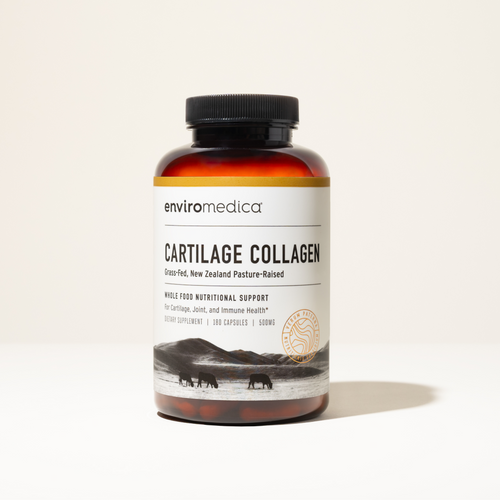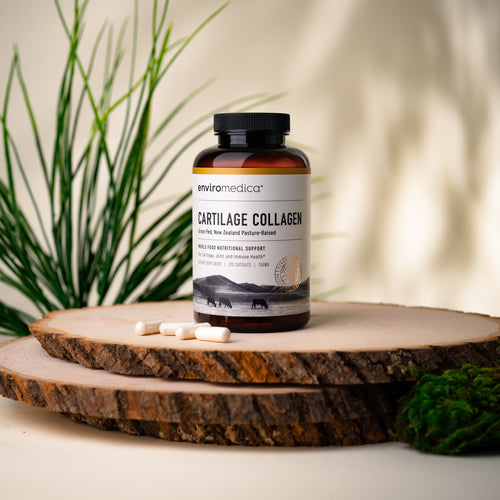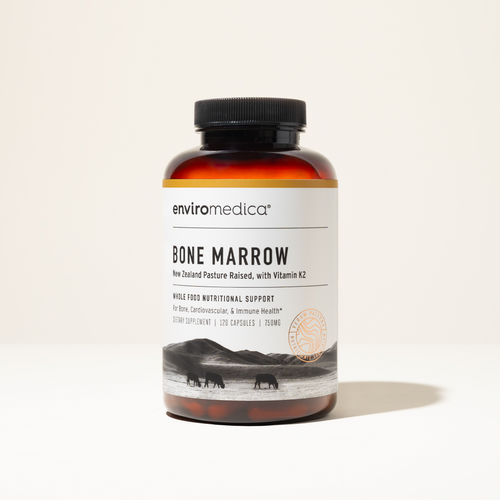Did you know collagen benefits go far beyond skin and joint health?
Most people have heard of collagen, which is commonly used in lotions for the skin, and supplements for joint health, but many don’t realize the powerful and broad support collagen can provide. Collagen is one of the most abundant proteins within the body; accounting for about 30% of the body’s entire protein content. It is because of this broad dispersion throughout the body that increasing dietary or supplemental collagen may have dramatic health-supporting benefits. 1
Scientists have identified at least 28 different types of collagen throughout the body, with the most abundant being type I, II, and III. Each type of collagen provides tissue specific benefits. The five most common types are:
- Type I: Over 90% of collagen in the human body; skin, tendon, vasculature ligature, organs, and bone.
- Type II: Cartilage.
- Type III: Reticular and commonly found alongside Type I.
- Type IV: Basal lamina.
- Type V: Cell surfaces, hair, and placenta. 2
Just by looking at the small list of the most common forms collagen takes throughout the body, one can ascertain the massive importance of having the proper variety in adequate amounts.
Collagen is created endogenously, most commonly by the fibroblast, but as people age they make less and less thus having a hard time keeping up with demand. A great dietary source of collagen is gelatin, which is the result of collagen being hydrolyzed and is commonly used in food products. You may be familiar with bone broth and the many health-supporting claims with which it is associated. Many of the claims can be largely attributed to the fact that bone broth is rich in gelatin formed from the hydrolyzing of collagen as you slowly simmer your choice of bones. Additionally, there are several high quality dietary supplement versions of collagen, many times separating out the type which is most specific to your goals.
1. Teeth, Nails, and Hair
While skin health is one of the common reasons people choose to use collagen, the same type which promotes your healthy, firm, and smooth skin, it is also an important building block of your teeth, fingernails, and hair. Additional collagen may help to promote healthy teeth, strong fingernails, and vibrant hair. 3 4
2. Intestinal Hyperpermeability
The amino acids found in collagen have the power to soothe and help support a healthy gut lining. Additionally, the power of collagen to support a healthy basement membrane is fundamental in the maintenance of healthy permeability of the gastrointestinal tract. 5
3. Liver Support
Collagen is extremely rich in the amino acid glycine. This amino acid is a key ingredient to the healthy function of phase 2 detoxification within the liver. Paired with the other amino acids and the importance of them for optimal liver function, collagen can be your “ace in the hole” to support your liver in its quest to detoxify compounds you’re coming across on a daily basis. 6
4. Hormone Health
The power of amino acids yet again. The impact of amino acids as precursors to import materials throughout the body cannot be understated. Glycine is also an important precursor to glutathione which is the body’s most plentiful endogenous antioxidant. Another important aspect of glutathione is that it supports the healthy metabolism of estrogen in the human body. 7
5. Skeletal Muscle Support
It is common practice for athletes to ingest amino acids with the goal of recovering faster and ultimately improving performance. The rich supply of amino acids found in collagen, or bone broth as gelatin, can provide similar benefit in the maintenance of muscle tissue throughout the body.8
6. Metabolic Health
In the human body it is becoming a more and more difficult task to maintain metabolic health with the pressures of modern-day society and the abundance of foods that provide not so great choices. Some of the most plentiful amino acids found in collagen or gelatin have been found to maintain healthy insulin sensitivity. Our ability to remain sensitive to the signals associated with insulin is a primary factor in the decline of metabolic health and ultimate increase in body fat stores throughout the body.
7. Bone Support
Beyond just the maintenance of healthy joints, collagen actually makes up 90% of bone mass. It provides easy to assimilate calcium, magnesium, phosphorus, silicon, sulfur, and trace minerals which are all essential to a healthy bone matrix. Some of the peptides associated with collagen even help to stimulate osteoblasts to lay down new bone matrix.
If you didn’t previously appreciate the vast benefits of collagen, we hope after reading this you realize how impactful some additional daily collagen or gelatin may be in supporting your quest for health.
About the Author:
Kathryn is a functional nutritional therapist, author, editor, and mama of two boys. She enjoys spending her free time out in nature-hiking and fishing. You can find her at www.primalmusings.com and her book “Forties on Fire” can be found on Amazon.
References
- 1. MacIntosh J Webberley D. (2016). What is Collagen? What Does Collagen Do?. Medical News Today. 2015. Available at: http://www.sciencedirect.com/science/article/pii/S0945053X98900646 Accessed June 3, 2016
- 2. Sherman, Vincent R. (2015). The Materials Science of Collagen. Journal of the Mechanical Behavior of Biomedical Materials 52: 22-50. doi:10.1016/j.jmbbm.2015.05.023.
- 3. Markus Schlee, Shahram Ghanaati, Ines Willershausen, Michael Stimmlmayr, Anton Sculean and Robert A Sader. (2012). Bovine pericardium based non-cross linked collagen matrix for successful root coverage, a clinical study in human.. Head and Face Medicine, 2012.
- 4. Wysocki AB. A review of the skin and its appendages. Adv Wound Care. 8(2 Pt 1):53-54, 56-62, 64 passim.. Available at: http://www.ncbi.nlm.nih.gov/pubmed/7795875 Accessed June 3, 2016
- 5. Vllasaliu D, Falcone FH, Stolnik S, Garnett M. Basement membrane influences intestinal epithelial cell growth and presents a barrier to the movement of macromolecules. Exp Cell Res. 2014;323(1):218-231. doi:10.1016/j.yexcr.2014.02.022.
- 6. Wang W, Wu Z, Dai Z, Yang Y, Wang J, Wu G. Glycine metabolism in animals and humans: implications for nutrition and health. Amino Acids. 2013;45(3):463-477. doi:10.1007/s00726-013-1493-1.
- 7. Dey P, Barros RPA, Warner M, Ström A, Gustafsson J-Å. Insight into the mechanisms of action of estrogen receptor β in the breast, prostate, colon, and CNS. J Mol Endocrinol. 2013;51(3):T61-T74. doi:10.1530/JME-13-0150.
- 8. Domingues-Faria C, Vasson M-P, Goncalves-Mendes N, Boirie Y, Walrand S. Skeletal muscle regeneration and impact of aging and nutrition. Ageing Res Rev. 2015;26:22-36. doi:10.1016/j.arr.2015.12.004.
















